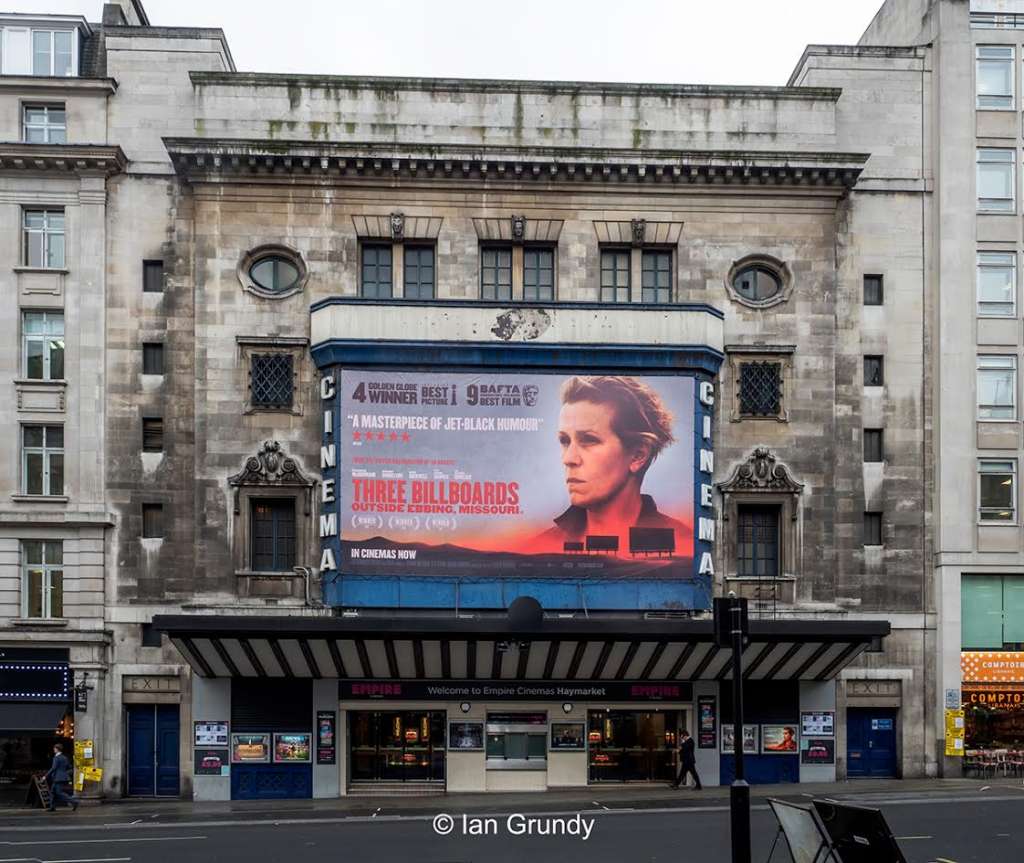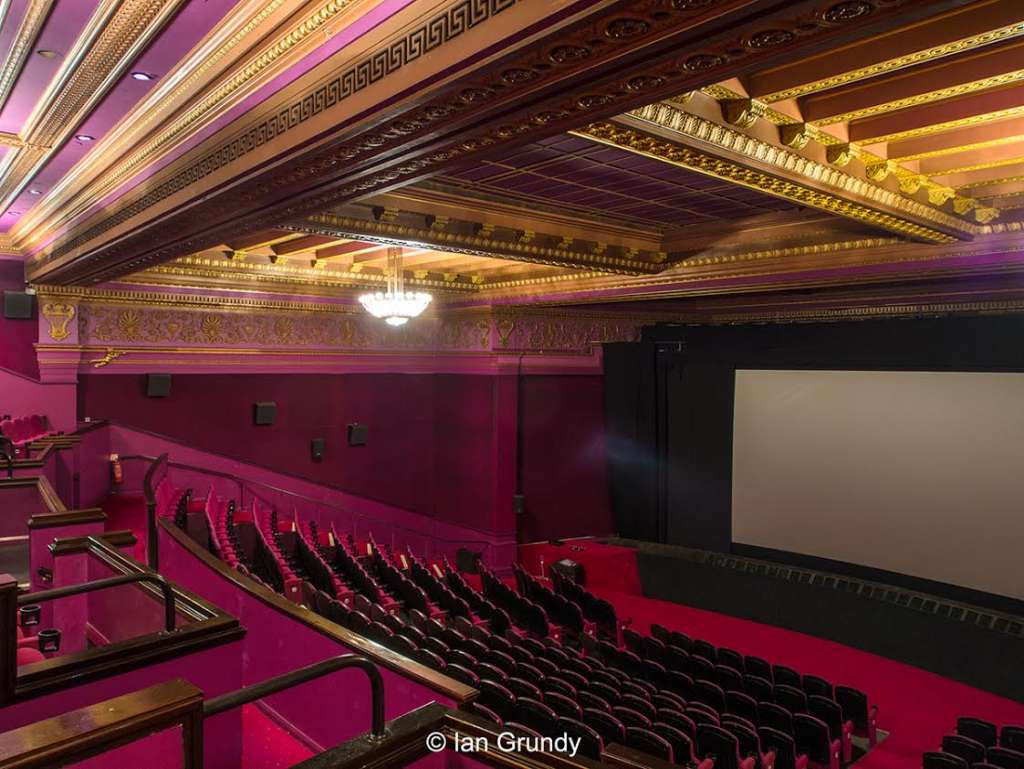Press release: SAVE Britain’s Heritage calls for urgent listing of last surviving grand 1920s West End cinema
The building's elegant front on Haymarket (left) and the original 1920s ceiling in the main auditorium (right). Photos by lan Grundy
Press release: SAVE Britain’s Heritage calls for urgent listing of last surviving grand 1920s West End cinema
23 April 2018
The battle is on to save the Empire Cinema – formerly the Carlton – on Haymarket. This building is the only remaining major cinema of the inter-war years in London’s West End which is both substantially intact and in use as a cinema and should be listed.
SAVE and the Cinema Theatre Association are vigorously opposing an application from the freeholder of the site, The Crown Estate, for an official Certificate of Immunity from the listing of the building. A Certificate of Immunity would allow the destruction of the interior of the 1927 cinema. Only the façade on the Haymarket has a measure of protection from the fact that it is in the Haymarket Conservation Area.
The Empire is the only grand Hollywood film palace left in the West End where patrons can still experience the glamour and splendour of the 1920s: a large foyer along the width of the whole building with festive neoclassical décor and elaborate stairs lead to the auditorium, bars and upper foyer, also lavishly decorated.
Though the stalls at the Empire have been subdivided into two smaller cinemas, the main screen still occupies the major part of the former auditorium. Its historic ceiling is virtually intact and the opulent decoration ingeniously integrates ventilation installations. Together with the highly ornamental frieze and elegant light fittings the space evokes the monumentality of Renaissance interiors. Hollywood film makers loved grandeur and show.
All the West End picture palaces have been altered in one way or another as, for instance, those surrounding Leicester Square – the Odeon, the original Empire (now Cineworld) and what was the Warner, now Vue, have all been drastically changed. The Odeon West End, the forth cinema in the square has gone completely. Elsewhere, the interior of the Plaza in Lower Regent Street has been totally lost, so too the London Pavilion in Piccadilly Circus, and the Astoria on Charing Cross Road has been demolished for a new Elizabeth Line station. This therefore makes the Haymarket Empire all the more special.
Marcus Binney, executive president of SAVE, says: “The Crown Estate should cherish their own heritage. In the immediate post war years, the Crown Commissioners proposed to demolish Nash’s magnificent Regency terraces around Regent’s Park and were only prevented from doing so by public outcry. We are determined to convince The Crown Estate that this unique palace of entertainment built in the 1920s should escape a similar fate and be protected by listing.”
Richard Gray, Chair of Casework for the Cinema Theatre Association, says: "The Empire in the Haymarket it the sole remaining cinema in central London to preserve substantial elements of its interior, an important survivor from 1927 and built by the major Hollywood film company Paramount Pictures as a showcase for its films. The internal decoration is of an undisputed high quality and is an excellent example of the period. It is vital for our heritage that this wonderful survivor continues into the 21st century".
The Empire, originally named the Carlton, was designed by Frank T. Verity in 1926, in partnership with Samuel Beverley. Frank's father Thomas is famous as the architect of many of London’s best loved Victorian and Edwardian theatres. Verity Jr. was an outstanding designer of theatres and cinemas in his own right. Verity Jr served as The Crown Estate’s theatre and cinema consultant at the very time when the Commissioners were rebuilding prime sites along the Haymarket and Regent Street to a new grand scale. Verity was also the architect of the cinemas in Buckingham Palace and Clarence House (listed as part of these buildings).
In SAVE’s view it is all the more important that the Empire continues as a cinema now that its near neighbour and contemporary, the Plaza, ignominiously accommodates a Tesco supermarket. The Haymarket was described by John Strype in 1720 as “a spacious street of great resort, full of inns, and houses of entertainment". Later came the establishment of the Italian Opera House at the bottom of the street, now the Theatre Royal. Opposite is Her Majesty’s Theatre which opened in 1897 and has been the venue for the record run of The Phantom of the Opera since 1986. The Empire is now the last operating historic cinema on this street.
The Empire was the venue for major film premières over four decades. When Wings, a rapturously-received silent movie about First World War pilots, opened in 1929 Winston Churchill came on two successive nights. There is a photograph of Charlie Chaplin and Marlon Brando in the foyer at the world première of a Countess from Hong Kong in 1967. Other notable premiers include: The Love Parade in 1929 with Maurice Chevalier, Top Hat in 1935 with Fred Astaire and Ginger Rogers, Henry V with Laurence Olivier in 1944, Daddy Long Legs in 1955 with Fred Astaire and Leslie Caron, The King and I in 1956 with Deborah Kerr and Yul Brunner, The Rains of Ranchipur in 1956 (with Richard Burton photographed in the Foyer).
Designed as both a cinema and playhouse the building is currently host to a production of Noel Coward’s famous play Brief Encounter. The popularity of this show demonstrates the Empire can play to a packed 400 seat audience. SAVE and the Cinema Theatre Association strongly believe that this unique cinema building should be added to the National Heritage List for England.
Note to Editors
1. For additional images and information please contact SAVE on 0207 253 3500 or by email office@savebritainsheritage.org
2. Historic England is currently assessing the application for a Certificate of Immunity from listing from The Crown Estate. COIs are valid for 5 years during which time no other listing applications for the site will be considered.
3. SAVE Britain’s Heritage has been campaigning for historic buildings since its formation in 1975 by a group of architectural historians, writers, journalists and planners. It is a strong, independent voice in conservation, free to respond rapidly to emergencies and to speak out loud for the historic built environment.


